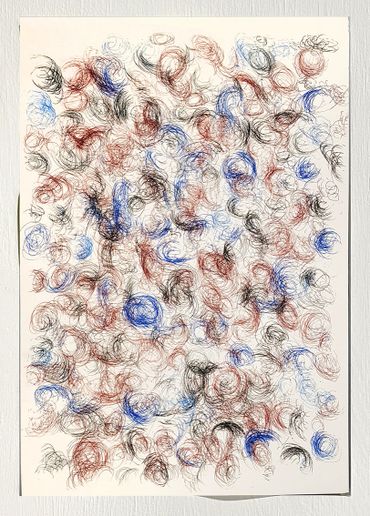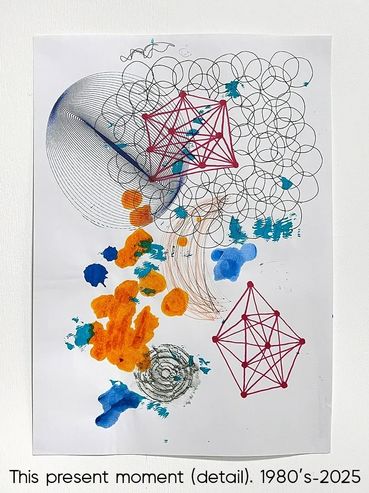Gary Warner
sound | drawing
6 June - 5 July 2025
Gary Warner’s SLOTprojects exhibition Sound | drawing was in 3 parts. In the window space he presented a drawing To be titled myriad, 2025 that stretched across the 3 meter width of the space. It was a catalogue of people and events, drawn cartoon-like as a jumble of images layer upon layer. There was a portrait of Einstein, a schematic drawing of a John Cage music performance, a rendering of “dollar bill”, a televised animation who introduced decimal currency to Australia in 1966. On and on it went recording the avalanche of thoughts considered by Garry across the period of a few weeks. Standing with Gary, admiring its completed installation he began reading it to me. Pointing out and discussing the events and ideas notated in particular elements of the drawing. There seemed to be no end to our conversation as it ranged, apparently randomly across the labyrinthian accumulation of Gary’s thoughts. Like any conversation with Gary, be it verbal, graphic or performative it revealed that for Gary there is great purpose in apparently random events.

In the smaller room of SLOT Gary presented another accumulation of drawing, This present moment, 1980’s - 2025. Made across an enormous time span and presented in an apparently random manner, it mapped in a comparative way Gary’s thinking about various modes of progression, from random to geometrically predictive.
Finally, three installations were set up in the large exhibiting space. Each celebrating the work of a fellow thinker who had examined aspects of randomness, a scientist and two composers.


%20(1).jpg/:/rs=w:370,cg:true,m)

%20(1).jpg/:/cr=t:0%25,l:0%25,w:100%25,h:100%25/rs=w:370,cg:true)



The botanist Robert Brown accompanied Mathew Flinders on his circumnavigation of Australia. Then in 1827 he observed the microscopic and apparently random motion of pollen particles suspended in water. In the early 1900’s Albert Einstein and others developed what is identified as Brownian Motion into a map known as the Kinetic Theory of Gasses, which in turn lead to an understanding of quantum mechanics.
Brownian Motion, colloquially at least, observes the randomness that governs our universe. Gary’s work, Songs for Robert Brown, 2014 is a disc-like instrument placed so that it can be manipulated by two people. The result, randomised patterns of sound that are contingent on the reciprocal actions of the participant performers. In this it is
reflective of Brownian Motion.

Sound drawing for Éliane Radigue, 2025, saw 3 piano wires each stretched between brackets fixed to the wall along a single line. At once it was a drawing of a single line, a linear sculpture and a musical instrument that could be plucked or tapped to produce a deeply resonate low B note. Radigue was a French avant-garde composer who began working with early electronic technologies in the 1950’s. By the end of the 20th century, she was working exclusively with acoustic instruments producing compositions that are described as minimal drone like sounds. With out notation these works were produced as direct collaborations between the composer and musicians. In this sound drawing the audience took on the role of musician and had the opportunity to consider the duration of a sound isolated within a given composition.

For me the central work in Gary’s show was Sound drawing for Cornelius Cardew, 2025. Cardew is celebrated as the instigator of the Scratch Orchestra. A collection of willing participants, trained and untrained musicians who responded to Cardew’s graphic scores in a subjective and improvisational manner. He celebrated the music of chance. In this sound drawing Gary gave us a remarkably beautiful arrangement of tin cans fashioned into bells that hung along a musical stave drawn on the wall. In a reference to Cardew’s book of graphic notation Treatise this instrument became its own subjective notation. It offered several performance options. Each beginning with a crescendo. Rather than slowly building, the sound decayed in a manner that proposed intense listening across a period of 4-6 minutes. Progressively it incorporated the ever-present traffic sound of the street outside. Progressively inverting an appreciation of the traffic noise from an intrusive sound into a concentration on the silences between the random coming and goings of sound.

The common thread of the three parts of Garry Warner’s exhibition Sound | drawing is an appreciation of incident and placement. That is the way events occur in time and the patterns that they appear to create, be they random or automatic. Traced as sound and drawing these patterns have an emotional appeal that is comparable to our elemental appreciation of natural phenome, such as a sunset, or a river flowing through a garden like valley or the whispered poetry of a loved one.
Copyright © 2003-2025 Slot - All Rights Reserved.